Bead Fishing For Trout: Easy Guide Secrets
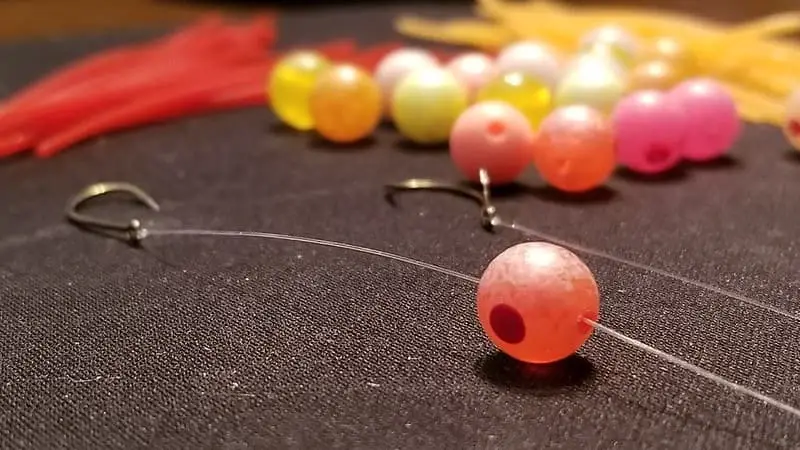
As a trout guide, I have many tactics and many baits that I use in different situations. Bead fishing for trout is something I have been doing for about 20 years. Beads account for many of the large trout my clients catch in the spring and fall when fish eggs are a part of the trout’s diet.
Trout beads come in plastic, glass, and soft rubber and require proper rigging, the best hooks, and the best presentations.
About Bead Fishing For Trout
Fishing for trout with beads involves using small hard or soft beads that are designed to imitate fish eggs. The hard beads have a small hole in the center to slide the line through. Setting up the bead properly and fishing it well is an effective way to catch trout in rivers.
Beads For Trout
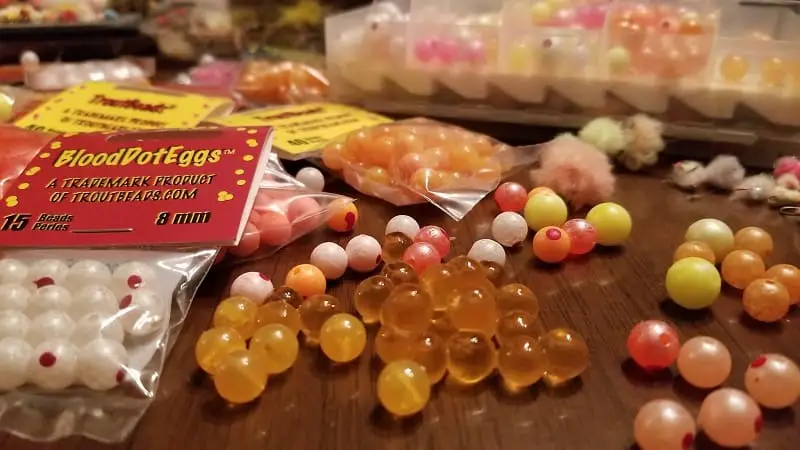
Trout beads can be rigged in a few different ways, and they come in hundreds of colors and a few different sizes. Trout beads have a small hole in the middle where your line goes and where you secure them to the line.
Knowing what size and color of trout bead to use is also important for catching more trout. I will discuss the trout bead rigs that I use, why I use these rigs, and when some colors and sizes of trout beads will work better.
What Are Trout Beads Made Of?
There are three main types of beads, and in this article, I will discuss the pros and cons of using glass beads, plastic beads, and soft beads.
The rigging of the beads is the same for the glass and plastic beads, but there is a difference when rigging soft beads.
It’s the hard trout beads that have everyone going crazy to use beads on trout, steelhead and they have also been great on salmon.
Plastic Beads For Trout
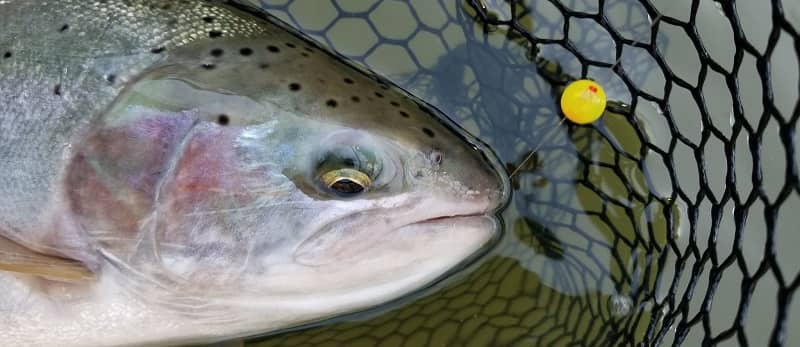
I use plastic trout beads more than any other type, and they work great for me. They are cheaper than glass beads but just as effective, and they come in a lot of great colors and sizes, from 6mm to 12mm.
I know some anglers will disagree about the plastic beads being just as effective as plastic beads, and I will explain why I think both plastic and glass beads can be equally effective and why some believe glass beads are better.
The best brand of plastic trout beads, and the one that I use the most, is called, Trout Beads.
Glass Trout Beads
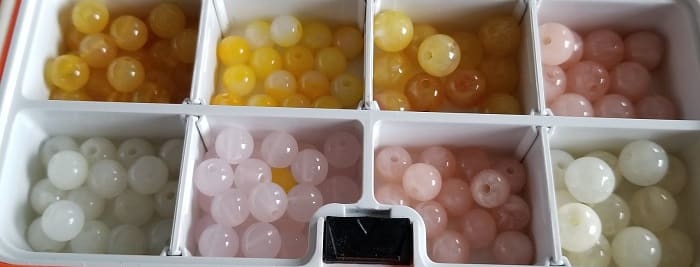
For many anglers, the best trout beads are glass beads because they find that they just catch a lot more trout on glass beads.
Glass trout beads are heavier and come in a huge assortment of colors and sizes from 6mm to 12mm.
Because glass trout beads and plastic beads look almost identical above and below the water and because even most anglers can’t tell the difference between the two in the water, I believe the trout can’t tell the difference either.
The reason why glass trout beads catch more trout than plastic beads for some anglers is simply because glass trout beads sink faster, which gets them in the strike zone faster. Glass beads also stay down and in the strike zone longer, which means more trout in the net.
Good anglers who know how to weigh their leaders properly should get just as many bites on plastic beads as they would on glass beads.
I have experimented with both glass and plastic beads using my trout and steelhead leader setups, and I find it is rare that one fishes better than another if set up properly.
Glass beads are also an excellent choice when fished under a float and when using my advanced bottom-bouncing method, which I discuss below.
Either way, you can’t go wrong with a glass or plastic bead.
The best brand of glass beads for trout is Creek Candy Bead Company.
Soft Trout Beads
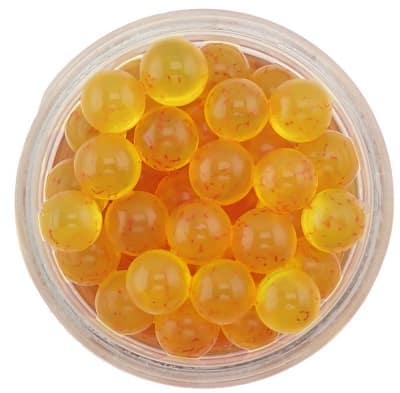
Soft beads are similar, except that they are made of soft rubber, plastic, or even organic materials, like the Berkley Gulp Alive! Floating Salmon Eggs and the Berkley PowerBait Magnum Garlic Power Eggs.
Check out Best Berkley Powerbaits For Trout.
The primary advantage of soft trout beads is that trout might hold onto them a little bit longer because they feel more natural.
My favorite soft trout bead when fishing beads for trout are the brown trout color Pautzke Fire Balls seen in the pictures or the Berkley Gulp! Alive! Floating Salmon Eggs.
I will discuss the pros and cons of soft trout beads vs. hard beads below.
Soft Beads vs. Hard Beads
The debate about which trout bead is more effective could go on forever. I use both types when trout fishing and these are the advantages and disadvantages of both. You may find one type of bead that works best for you.
The three primary advantages of soft trout beads are:
- Trout might hold onto soft beads a little bit longer because soft trout beads feel more natural in their mouths, but it’s an artificial bait that trout spit out quickly.
- Some anglers believe that soft beads allow for better hook sets and will allow the hook to stay lodged in the trout’s mouth better. I’m not sold on this after hooking and landing thousands of fish on hard beads.
- Soft beads are very simple to change out for different colors.
The disadvantages of soft trout beads are:
- The soft beads can slide down on each hookset or even when dragging across rocks, sticks, and missed fish.
- They become virtually useless because the inner hole will get too big, and they won’t stay pegged in place. You will go through a lot of soft beads.
- 6mm and 8mm soft beads tear off easily, and these are often the best sizes for trout.
- Soft trout bead colors are very limited compared to hard beads.
The advantages of hard trout beads are:
- The color selection is great.
- 6mm and 8 mm hard beads stay on the line.
- Hard beads can be reused.
- Hard trout beads come in different sinking rates, from slow-sink with plastic trout beads to fast-sink with glass trout beads.
The disadvantages of hard trout beads are:
- Hard trout beads are not as easy to put on.
- Changing colors is not easy and requires you to cut the hook knot each time you want to use a new color.
- Hard trout beads are more likely to be spit out by the trout faster.
- Some anglers believe that hard trout beads can act as a pivot point when a fish is fighting and cause the hooks to dislodge more easily.
I would choose hard beads over soft beads most of the time, and due to the popularity of hard trout beads over soft trout beads, I think most anglers would agree.
Best Size Beads For Trout
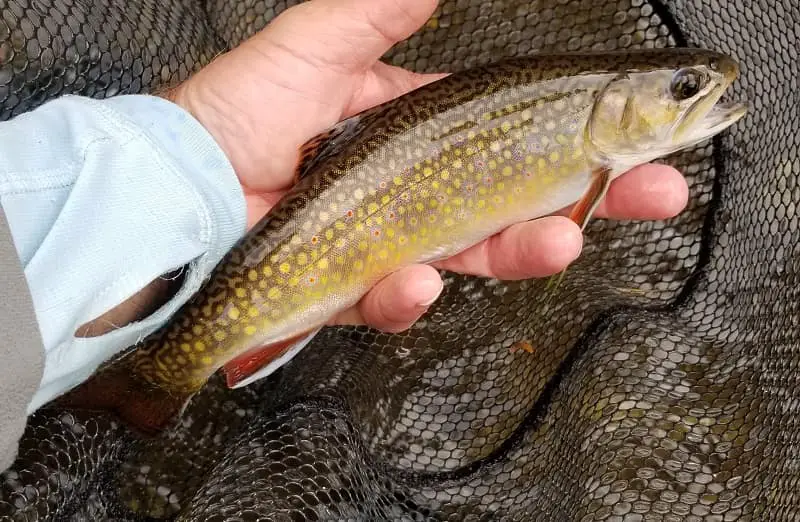
There are four sizes of trout beads that I will use.
6mm beads are great for trout in low clear water or when the trout are heavily feeding on eggs from other trout.
There are times when the trout will only eat these small 6mm beads, so it’s important to ensure you have a good selection of the right colors. See my color chart and size chart below.
8mm beads are about the size of a real salmon egg. I use these the most to catch trout. The bigger beads are easier for the trout to see than the smaller beads, and that can be a good thing.
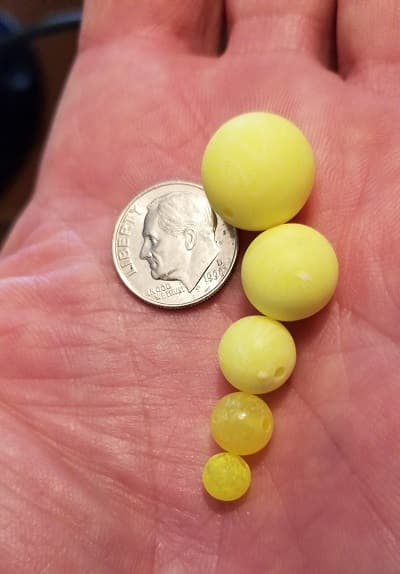
Don’t be afraid to try the 8mm trout beads at any time because there are times when the trout want bigger beads.
10mm beads are good in slightly dirtier water and in fast water.
This 10mm bead size will get their attention at times, and it’s good to have in my preferred colors for off-colored water. See Below
12mm beads are a bit harder to get, and I only use them in really high fast water or when the water is dirty.
Best Bead Colors For Trout
I use a lot of bead colors, but I have found a few colors that seem to work for everyone.
I will change my colors based on the time of year and the water conditions.
If there are other fish spawning in the area, the natural fish eggs in the water that the trout are already feeding on will often be orange or yellow-orange in color, so the best bead colors will be ones that match the natural eggs.
Matching these natural colors has been the most effective method for me, but there are times when other not-so-natural colors will be better.
I will change to bigger beads and brighter colors in dirty water.
I will also use bigger beads in faster water because they stand out better.
Match your bead color to the type of water you are fishing using my trout bead charts below.
Plastic Beads Chart
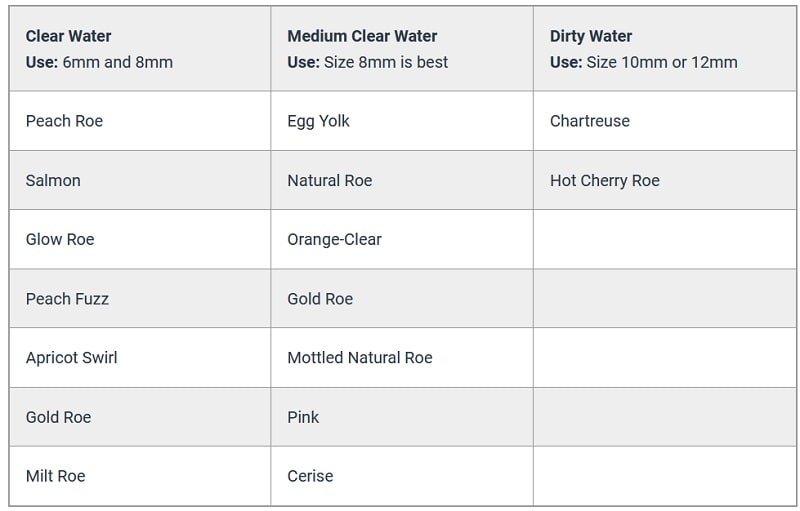
For glass beads, these are some of my best trout bead colors:
Glass Trout Bead Chart
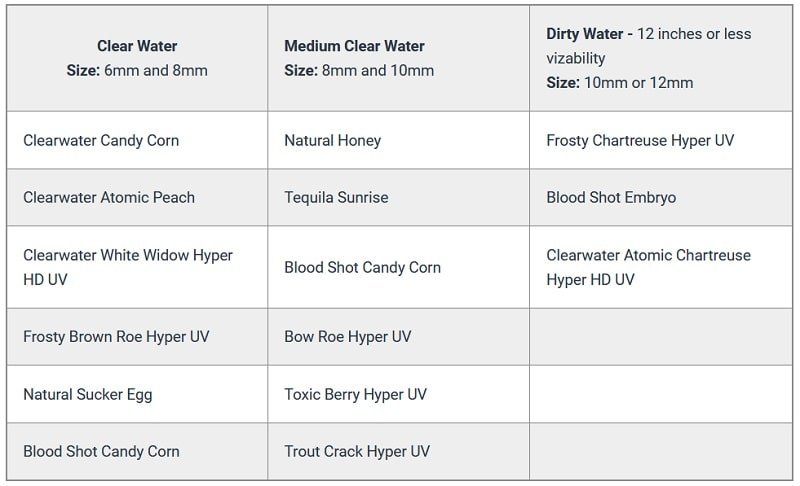
How To Fish Trout Beads
I fish beads for trout the same way I fish all my other good trout bait, which is with a dead drift, meaning no pull or drag on the bead. The only difference is how I rig a bead.
I fish beads below a float, or fly fishing with an Indicator, or using my advanced bottom bouncing method, which is the best method for any bait in shallow water and pocket water.
Still Fishing With Trout Beads
Beads have no scent, they sink to the bottom where the trout are less likely to see them, and they are hard, which is not good.
Even if a trout puts a hard or a soft bead in its mouth, it won’t feel or taste natural, and the trout will try to spit it out quickly, which is why I never use beads when still fishing. There are much more effective baits for still-water fishing.
Do Trout Beads Float?
The trout beads that I use will either sink fast like the glass beads do, or be almost neutral buoyancy but sink very slowly like the plastic and soft beads.
Even beads that do float, like the Berkley Floating Eggs, will often still sink slowly once you add a heavy hook.
You want the beads to get down to the trout as fast as possible so heavy beads are better.
Trout Bead Setup
These are my three best trout bead rigs that work for me in different situations.
The Single Trout Bead Rig Setup
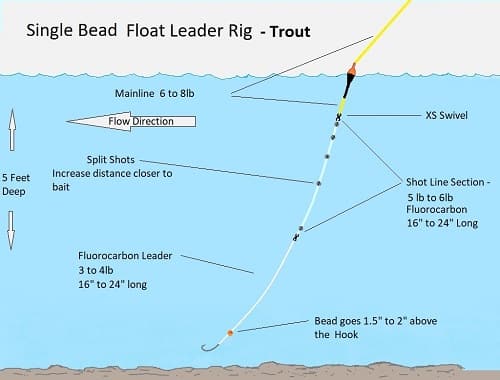
This is a great trout bead rig when you are fishing in very clear water or water under 8 feet deep. It’s a good rig when the trout are close to the bottom.
This trout bead rig is designed to be used below a float, and it works best in water from 3 to 8 feet deep.
Fishing with a float in less than 3 feet deep is not so good. Your float just gets too close to them and could spook the bigger trout, which means fewer fish. In shallow water, use the bottom bouncing method, which I discuss below.
Float fishing with a bead or any type of bait is only good if you know how to do it right. My experience on the river has shown me that over 80% of anglers fish poorly limiting their success.
There are four fundamentals to float fishing that I have proven through 20 years of guiding to catch up to 10 times more fish. You can see these fundamentals on my float fishing page
The Double Trout Bead Rig Setup
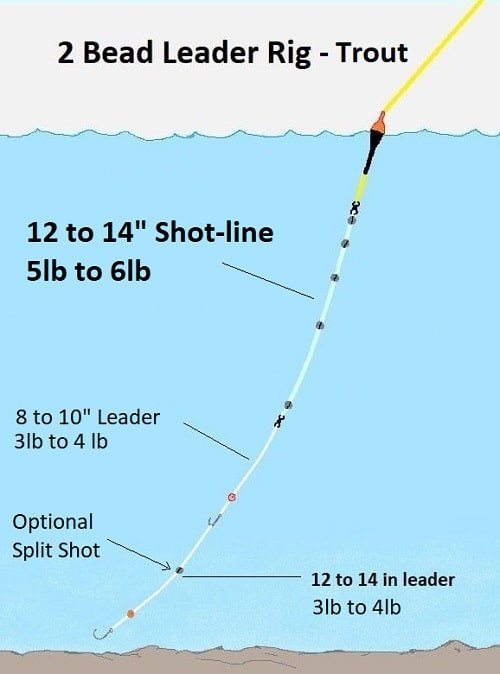
If allowed to use more than one hook, I will use this two-bead rig.
The advantage of this two-bead setup is that I can cover two different feeding levels at once.
I try to keep my lower bead about 6 inches off the bottom and my upper bead 12 to 16 inches off the bottom.
Even if one bead is dragging the bottom, the upper bead should be in perfect position.
This rig also gives you the opportunity to experiment using two colors or two different sizes at a time to see what the fish want.
There is a time when two beads are not as effective. I call it too much junk on the line, and too much junk coming down the river at once, and that can sometimes make the trout wary and stop them from feeding.
The Bottom Bouncing Bead Rig Setup
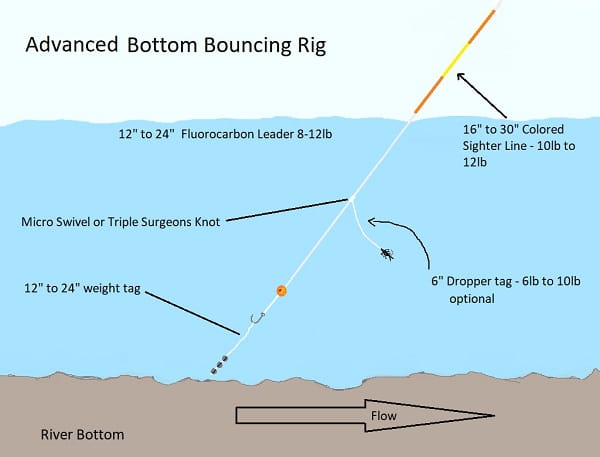
This Bottom Bouncing bead setup is great in smaller spots, pocket water, and when the water is under three feet deep and as shallow as twelve inches.
The weights on the bottom get everything down fast, but if you are using glass beads, you may not need as much weight or none at all.
If you want to know how to bottom bounce better, check out my page, Bottom Bouncing – 5 Proven Guide Tips For More Fish
How Do You Peg Hard Beads
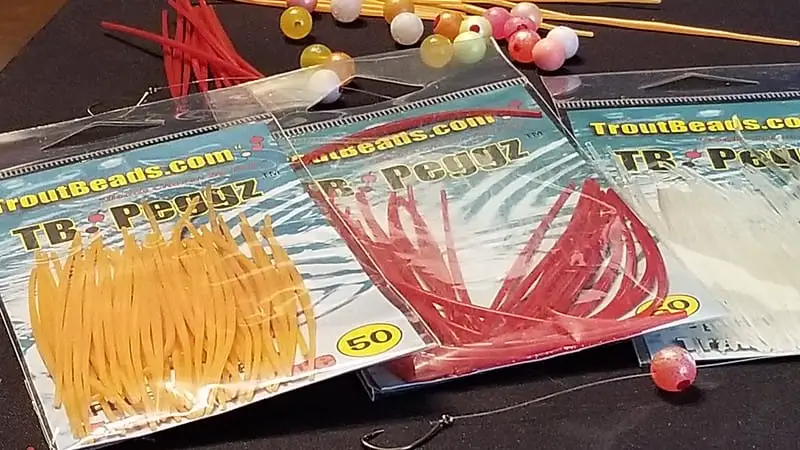
There are a few ways to peg hard beads for trout.
Pegging a bead means securing it on the line about 1.5 to 2 inches up from the hook.
When you secure a bead on the line, you actually want it to slide when you set the hook for a better hookset.
I know some anglers say not to do this because a bead up against the hook can be used as a wedge to pry the hooks free, but I have seen fish grab beads hard, and then the hook never touches them on the hook set.
When rigging your trout bead, you want the bead to only be 1.5 to 2 inches up from the hook. This keeps the hook away from the bead, so the fish do not see the hook.
The bead up the line also gives you a hookset on the outside of the mouth, which is better because the hook tends to grab more flesh and will hold better on the outside of the mouth.
If you run your bead more than 2 inches or more up the line, you are more likely to hook the fish in the eye or the gill plate, which will not hook or hold big fish as well, and you will lose more trout.
4 Ways To Peg Trout Beads
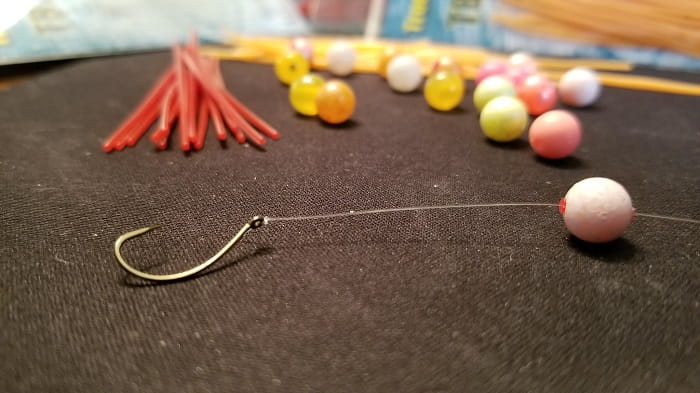
To peg the trout bead on the line, some anglers will use rubber bobber stops between the bead and the hook and then pull the bead hole as far over the rubber stopper as possible. This works just fine and is worth a try.
Another way to peg a trout bead on the line is to wedge a toothpick in the hole of the bead and break off the toothpick in the hole to secure the trout bead on the line. It can make your bead more buoyant, which you don’t really want.
Some guys will take a thin rubber band, pull it through the bead hole, and then cut off the excess rubber band on both sides. I’m not a big fan of this method because it takes a few extra steps and it requires a 12-inch piece of thing fishing line to pull the rubber band through, however it does work.
Some guys will tie a special double loop around the bead to secure it in place, and of all the methods, this is the one I dislike the most as I believe this could be the weak link in your leader.
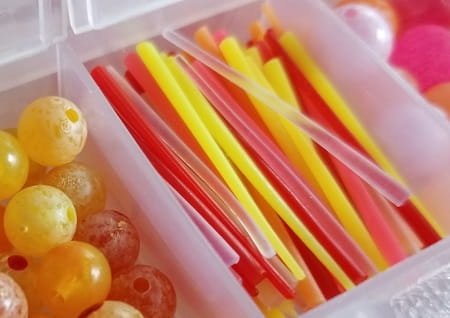
The best method for pegging your bead to the line is to use a bead peg, which you can buy at the same place you buy your beads.
I usually use the red bead pegs, but the clear bead pegs are also good. Some anglers like the chartreuse and the orange colors.
Bead pegs give you lots of options, and they are easy to use. Simply put the thin end in, pull it until it is tight, and snip off the excess.
Bead Peg Steps
- Take a piece of leader about 12 to 20 inches and tie on a hook (putting the hook on first makes it harder to drop the bead)
- slide the bead on the open end of the leader and let it slide down the line to the hook.
- Slide a bead peg, small end first into the bead hole, and pull it until it’s tight.
- Slide the bead up about 1.5 inches above the hooks.
- Pull one end of the line around the hook so it is tight to the hook so you can cut the bead peg close to the bead without cutting the line.
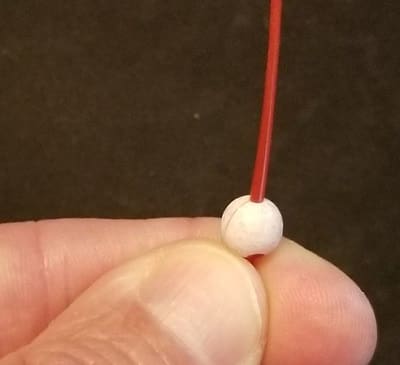
With all of these methods, a good pair of nippers is great for trimming the excess off the bead pegs, just be careful not to cut or nick the leader.
You can see my favorite nippers on my page, Best River Gear.
Trout Bead Hooks
I like to use small wide gap hooks like the Raven Specimen hook or the Gamakatsu Octopus hook.
If the water is really clear and a more stealthy setup is required, I will often change to a Raven Sedge hook or the Daiichi 1150 hook.
In fact, on my page 11 Best Hooks For Trout: What The Guides Use I list the Raven Specimen and the Daiichi hooks as my top two hooks.
I discuss the best hook sizes for beads below.
What Size Hooks For Trout Beads
In clear water, the best bead hook size is a size ten or size twelve hook.
Hooks that are too big could weigh down your trout bead and possibly drag it across the bottom or make it unnaturally drift through the current.
Hooks that are also too big might be seen by the trout preventing them from biting the trout bead.
Set The Hook Fast When Fishing Trout With Beads
I have seen trout put chunks of debris, seaweed, bark, and sticks in their mouth and then spit them out in a second or two. Trout sample things they think might be food.
When a trout puts a hard bead in its mouth, they also spit it out super fast.
This is why I set the hook lightning-fast. It’s also a great reason to use a sensitive float made for river fishing, like the ones I discuss on my page, 5 Best Floats.
Are Beads Legal
As I’m told, pegging hard beads up the line and not on the hook may not be legal in some areas that require something on the hook.
Since we peg the bead 1.5″ to 2″ up the line, a bare hook may be illegal, so double-check the local fishing regulations.
Best Trout Bead Containers
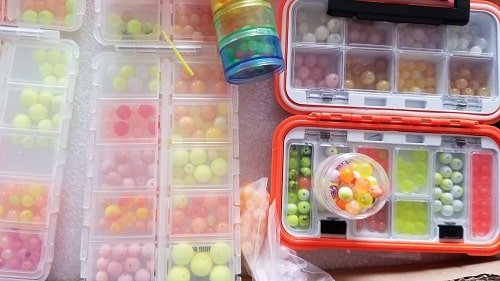
There are many boxes available to put your trout beads in, but if you want the best box for trout beads that can hold your beads safely, try the Troutbeads Bead Box.
You can also buy bead assortments that come in a case already. One of the best bead assortments is the Troutbeads Steelhead Selection by trout beads
Tight Lines
Graham

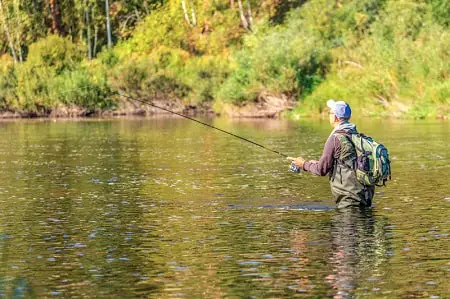
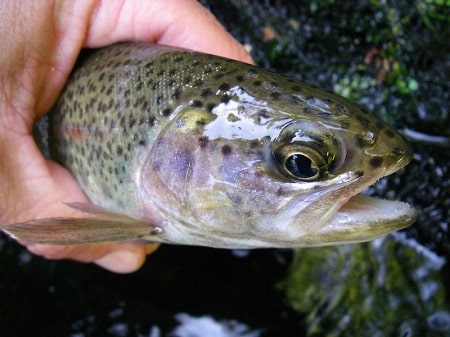
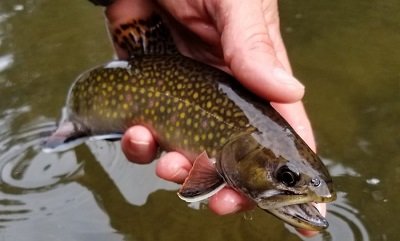
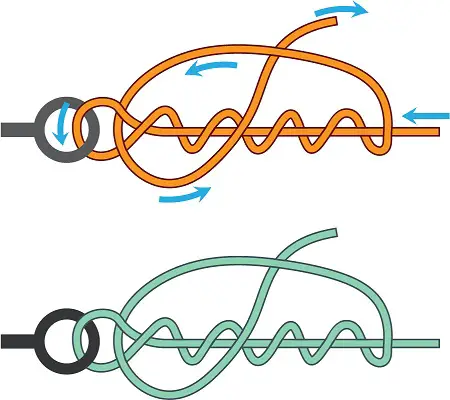
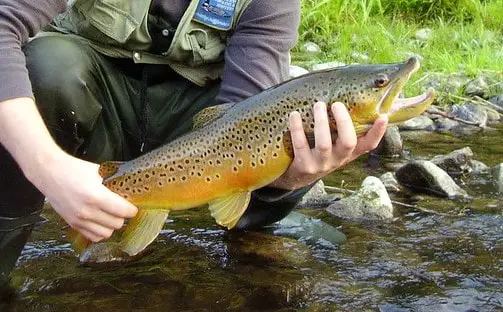
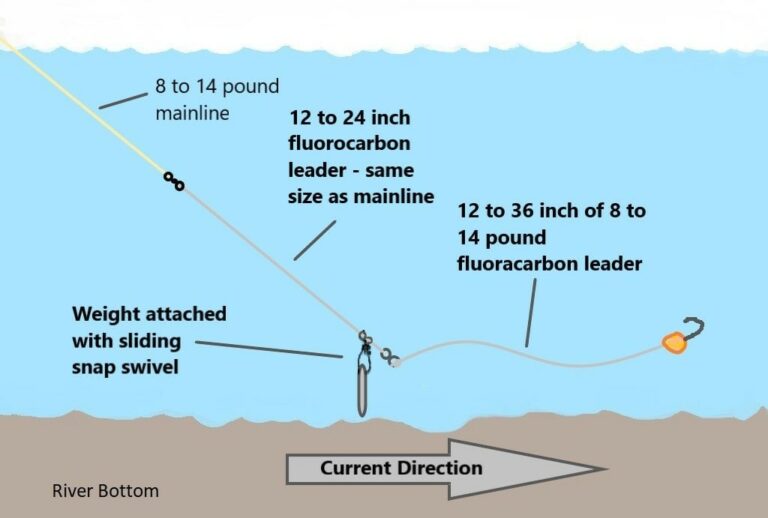
Get your beads at a hobby store way cheaper and more choices
Would this technique work in a stocker stream? I don’t have any naturally spawning trout streams in my area
It should, they often feed or put things in their mouths out of instinct or curiosity. Give it a try.
If I recall correctly, somewhere on your site you say that you prefer to tie your bead hooks to your tippet with a knot rather than snelling them. It seems to me that snelling a hook such as the Raven Sedge would result in more hook ups because the hook is pulled straight into (or outside) the trout’s mouth, but I would love to hear your thoughts on the matter.
Hi Alex,
Without going back and reading my bead article, I believe have mentioned multiple ways to rig a bead, which includes a bead knot or bead line wrap, however, I almost always use a rubber bead peg which allows the bead to slide down on a hook set. I believe this increases the hook-up percentage.
I generally tie a knot to the eye of the hook, however, a snell knot would work just as well.
Graham
Sorry for the barrage of questions, but I find this stuff really interesting. Thanks for the great ideas, Graham.
Now, for your bottom bouncing rig (a variation of the drop shot idea, right?), how do you attach the bottom tag (the one that holds the weight) to the hook? Do you tie it to the bend of the hook, or do you have another way of attaching it?
Hi Alex,
To prevent tangles I prefer to tie the dropper tag off the bend of the hook. I may revise this in the near future since you can also tie the tag fromthe hook eye, or use a tippet ring.
Hope that helps.
Good luck buddy,
Graham